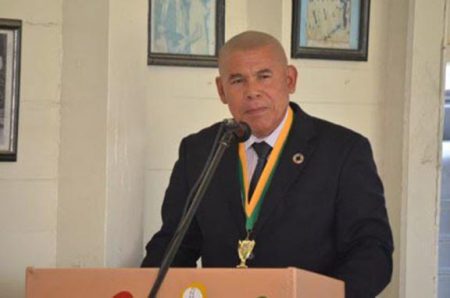Social Cohesion Minister Dr. George Norton says he authorised the rehabilitation of State House in the absence of a constituted board of the National Trust and that despite the public outcry, he sees no problem with the green colour it was repainted in.
“…He hadn’t to tell them [the National Trust] …His minister [Norton] should have been the person to tell him what to do because his minister at that point in time was the person with authority because the board was not constituted,” Norton told Sunday Stabroek in an interview, where he insisted that permission was given following discussions with President David Granger, although he did not say when those talks took place.
State House is a national monument and falls under the care and control of the Trust. Last November, it became noticeable that the building was being repainted. Although the president subsequently brushed aside concerns, the Trust had said that it was never notified about the repairs or the repainting, although the National Trust Act states that failure to get written consent from the body for interfering with a monument is unlawful.
Sunday Stabroek has learned that the Ministry of the Presidency, in response to a letter that was written by the Trust, formally informed it of the works last December and sought permission for it.
Norton, however, reiterated that the reality of the situation at the time the works were initiated was that the National Trust’s board was not constituted for a series of reasons. Because of this, he said that National Trust could not make any pronouncements.
Sunday Stabroek was unable to ascertain the exact date when the board was constituted. It is also unclear why permission could not have been sought from the Trust in the absence of the board.
‘Had to act’

According to Norton, there was a decision between him and the president and following conversations the go-ahead was given for the rehabilitation works to commence.
He said that it is clear that State House was in disrepair. “He had to act and in so doing he consulted. He did change the material [but] using the same style that was there before. The only thing he did was… he painted it and in so doing he chose a colour that is aesthetic, that makes it look so much better than it was before and we see nothing wrong in that,” he stressed.
According to the Minister, the President in a letter to him also indicated his reasoning behind choosing the colour green, which included the country’s drive to become a green state.
Asked if a colour was discussed prior to the commencement of the works, Norton responded in the negative. “No. No. The colour was not discussed or, even if it was discussed, it was never considered anything too compelling or of too much importance particularly since it is a mild something…,” he added.
The green paint has a broader context as it has been seen as a deliberate attempt by the government to perpetuate the predominant colour of the governing coalition. Green is also associated with A Partnership for National Unity and its largest constituent, the People’s National Congress Reform, both of which are led by Granger. The Ministry of the Presidency is also being painted in the same green even though this had not been the original colour. At one point, canary yellow had also been introduced in the colour scheme of the Ministry of the Presidency but it was painted over. Yellow is the predominant colour of the other member of the governing coalition, the AFC. Weeks after winning the 2015 general election, green and yellow paint began appearing on a range of items in public places and this attracted criticisms.
Though Granger had insisted that no laws were broken, the National Trust Act clearly states that failure to first get written consent from the body attracts a minimum penalty of a fine. “Any person who disturbs, removes, undermines, defaces or in any manner damages or interferes with any national monument or anything therein or thereupon otherwise than in accordance with the written permission of the National Trust is liable on summary conviction to a fine of one hundred and thirty thousand dollars, and in those proceedings the court may, in addition, order him to pay such sum as the court thinks just for the purpose of repairing or restoring the monument,” Section 17 of the National Trust Act states.
“I am not aware that a law has been broken… I am not aware that in fact National Trust needs to worry about the present decision to ensure that State House is in good repair… it doesn’t leak,” Granger had said when asked.
Nirvana Persaud, the Trust’s Chief Executive Officer, had previously stated that the Trust was never officially told about any repairs but because of the close proximity of its offices to State House, it noticed the works.
Persaud had explained that the Trust is supposed to be informed about any plans to repair a heritage site. “We weren’t informed at all…,” she said before making it clear that the Trust has no problem with the repairs being done. “We welcome any historic property being repaired but recently ….we noticed they changed the colour… major changes, such as the colour and repairs, generally once it involves changes, ought to be communicated to us and discussed so that we are all on the same page. I know the president and us, we are for preservation,” she said.
Persaud had informed that she has noticed that more windows on the building have also been replaced with modern ones.
“It is a national monument under the National Trust law, so for that reason it should have been communicated. Maybe it was an oversight,” she added.
As a result of the situation, Persaud said a letter would be penned to the Ministry of the Presidency (MoTP) about the matter.
Seeking permission
The Trust wrote to MoTP about the repairs and repainting and was later furnished with a response.
Sunday Stabroek saw the response, written by MoTP Permanent Secretary Abena Moore on December 8th, 2017, who indicated that a thorough examination revealed that State House was in “dire need of rehabilitation” due to dilapidated wall boards around the periphery of the building, rotted wall frames in some areas, leaking roofs at various points due to aged zinc sheets, and rotted and dislocated shutter windows, among other unforeseen repairs.
Moore added that a “decision” was also made to repaint the building light green in reflection of the national policy of promoting the green state agenda.
“The Ministry wishes to formally notify the National Trust of this rehabilitation and also seeks permission in accordance with the National Trust Act requirement. Please be assured that due consultations would be held in the future if or when any additional works are required,” Moore further wrote.
Norton stressed to Sunday Stabroek that the process of repairing State House went according to how it was supposed to and he was satisfied that no wrongdoing took place. “You have got to remember the president has his prerogatives,” he said.










